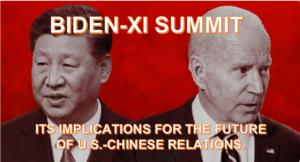 The November 15th San Francisco summit between Presidents Biden of the U.S. and Xi Jinping of China is now history. While we can all breathe a little easier as a result of their joint pledges to reduce tensions and improve cooperation on climate change
The November 15th San Francisco summit between Presidents Biden of the U.S. and Xi Jinping of China is now history. While we can all breathe a little easier as a result of their joint pledges to reduce tensions and improve cooperation on climate change
and other issues, the structural forces that drive U.S.-Chinese competition in the military, economic, technological, and diplomatic arenas persist.Please join us on December 13 @ 7:00PM EST for an experts’ webinar on the Biden-Xi Summit and its implications for the future of U.S.-Chinese Relations.
Michael Klare, Professor Emeritus of Peace and World Security Studies at Hampshire College and defense correspondent, The Nation
|
|
Yun Sun, Senior Fellow and Co-Director of the East Asia Program and Director of the China Program at the Stimson Center, Washington, D.C.
|
|
Zhiqun Zhu, Professor of Political Science and International Relations at Bucknell University
|
|
From Michael’s analysis:
“On Nov. 14, the U.S. Department of State and the Chinese Ministry for Foreign Affairs published the text of the “ Sunnylands Statement on Enhancing Cooperation to Address the Climate Crisis,” an agreement between the U.S. and China for deeper cooperation in overcoming the global climate crisis. The agreement was negotiated Nov. 4-7 at the Sunnylands estate in southern California by U.S. Special Presidential Envoy for Climate John Kerry and China’s Special Envoy for Climate Change, Xie Zhenhua. The Biden administration has placed a high priority on enhancing U.S.-China cooperation in the climate field, viewing such cooperation as a means of both slowing planetary warming – a key objective given that the U.S. and China represent the world’s top two emitters of heat-trapping greenhouse gases (GHGs) – and of balancing U.S. hostility and competition in other fields…”
|
|
 The November 15th San Francisco summit between Presidents Biden of the U.S. and Xi Jinping of China is now history. While we can all breathe a little easier as a result of their joint pledges to reduce tensions and improve cooperation on climate change
The November 15th San Francisco summit between Presidents Biden of the U.S. and Xi Jinping of China is now history. While we can all breathe a little easier as a result of their joint pledges to reduce tensions and improve cooperation on climate change 









